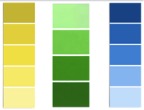Note: There were no Communication Experiments for Sessions 12–16, 18, 20–21, and 23–27.
Session 10
Defining deceptively simple terms
- Each group of students receives a piece of paper with one of the following words:
- HARD/HARDIER
- NOISE
- EXPERIENCE
- Group members write down their individual definitions of the term, and then share their definitions with each other.
- They turn the page over and read the author’s definition of the term (see “Authors defining deceptively simple terms”).
- Students discuss whether the specificity and accessibility of the definition ensures that all readers will understand what the term means in the context of the article or book.
- Each group presents their deceptively simple term to the class, the range of initial definitions/understandings within their group, the author’s definition, and why they think the author’s definition is effective or ineffective.
- Students review their own drafts for deceptively simple words and attempt to generate more precise alternatives and/or explanations.
Session 11
Translating units
- The class is presented with a unit of measurement, and, working in groups, students answer the following:
- What does this unit abbreviation mean, and what does it measure (e.g. Distance? Time? Weight?)
- Compare the unit to another unit of measurement (e.g. square feet to acres)
- Compare the measurement to an animate or inanimate object that would be familiar and accessible to the public reader.
- Share an interesting factoid(s) related to your measurement that might interest your audience.
- For example: "6mph"
- 6 mph means “6 miles per hour,” so mph is a unit to measure speed
- 6 mph = 31,680 feet per hour = ~9.7 kilometers per hour (km/h)
- The average walking speed of most humans is ~3 mph, so to help visualize the speed of 6 mph, you can imagine everyone around you walking twice as fast all the time.
- Olympic runner Usain Bolt was recorded at a top speed of 27.3 mph. Cheetahs are capable of running at 68–75 mph.
- Units given to the class:
- 300,000 lbs
- 1nm
- 57,600 square feet
- mach 1
- 800 ppb
- 40 gallons
Session 17
Session 19
Turning a topic into a research question
Students take the initial topics from the “Formulating a Research Question” section and generate as many different central questions as they can for each topic.
Session 22
Describing color with precise language

Working in small groups, students choose a single color tile from the swatches pictured here. Each group must describe the specific color using metaphor, imagery, and precise description, without explicitly comparing their specific color to the other color tiles on the swatch.
Each group reads their descriptions aloud, and their classmates attempt to guess which tile has been described.
